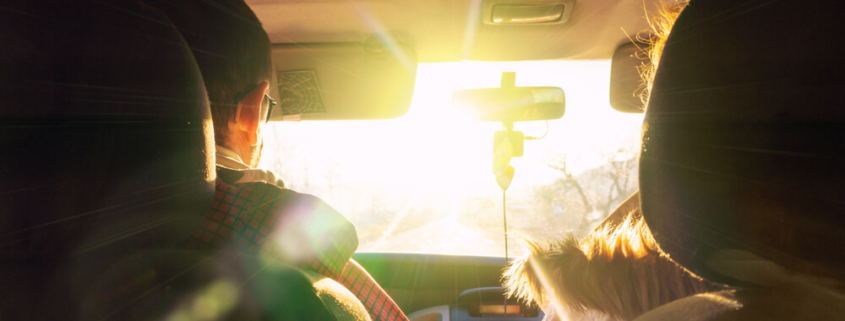How to Prevent Accidents Caused by Sun Glare
During the fall and winter months, sun glare can be a major problem while driving. In the summer, we benefit from maximum hours of daylight, which means the sun is usually up before most of us head out the door to work, and the daylight remains until well after we get home.
As the days get shorter, those of us who drive east in the morning and west in the late afternoon often encounter the blinding glare of bright sunlight coming through our windshield. This problem is at its worst during rush hours between the months of November and February.
According to the National Highway Transportation Safety Administration (NHTSA), bright sunlight is the cause of only a few hundred auto accidents each year. However, other organizations such as AAA dispute this figure and believe the real number of sun glare accidents is underreported.
Oftentimes, sun glare is not the sole cause of an accident, and it is not usually listed on the police report. But a study by the National Institutes of Health (NIH) found that bright sunlight was present in approximately one-third of all crashes that occurred during daylight hours. This is a strong indicator that sun glare contributes to far more accidents than official reports might show.
Who is Responsible for a Sun Glare Accident?
Sun glare can make driving situations that are normally fairly easy to deal with much more challenging. Some examples include:
- Seeing red taillights in front of you, which you need to identify to help avoid a rear-end collision;
- Seeing pedestrians (such as school children) crossing the street when trying to make a right-hand turn;
- Noticing other vehicles, motorcycles, or bicycles that enter your blind spot;
- Following the lines on the road that help you stay in your lane;
- Merging into highway traffic and seeing the right lane markers to exit the highway.
So, if a driver encounters one of these or other adverse road conditions and bright sunlight causes them to crash into another vehicle, object, or individual, whose fault is it? Some drivers might argue that sunlight is an “act of God”, and therefore, they are not responsible for it. This is not the case, however, and this argument will not hold up legally.
Acts of God are extraordinary natural events that are unforeseen and unavoidable. Examples include earthquakes, hurricanes, flooding, lightning, and hailstorms. If one of these types of events is the exclusive cause of an auto accident, then the driver might have a legitimate “act of God” defense. But bright sunlight does not fall into this category.
Drivers are well-aware that the sun rises and sets every day, and they should be aware of the general time of day both of these events occur. Sunlight is predictable, and drivers have a duty to exercise reasonable care to prepare for the possibility of encountering bright sunlight when they drive. Therefore, sun glare accidents cannot be blamed on the sun – they are fault of the driver (or drivers) who cause the accident.
Ways to Prevent Sun Glare Accidents
We all have to deal with bright sunlight at one time or another when we are driving, and it is incumbent upon us to prepare for this situation and minimize the chances of sun glare resulting in an accident. Toward that end, here are some steps to take:
- Clean Your Windshield: If your windshield is dirty and/or there are streaks and marks on it, this will make the glare of the sunlight even worse. Streaks are often caused by faulty wiper blades that need to be replaced. As we enter this season, make sure your wiper blades are in good working order (if not, replace them), and be sure you always have plenty of washer fluid in your vehicle.
- Make Full Use of Sun Visors: The sun visors in your vehicle can be helpful in blocking out at least some of the glare. You may also want to consider investing in sun visor extenders that provide additional protection from bright sunlight.
- Wear Polarized Sunglasses: A good pair of sunglasses can go a long way in protecting you from glare, and polarized sunglasses are the best type for these purposes.
- Keep Your Distance: When you encounter bright sunlight, it is more difficult to judge the distance between you and other objects and individuals. In this situation, it is best to drive slowly and allow plenty of distance between you and others on the road.
- Adjust Your Route and Drive Time: Whenever possible, try to make some adjustments to the route you drive and even the time of day when you leave for work and come home. Some alternative routes may allow you to do more north/south driving. And sometimes, even just a few minutes of difference in your drive time can allow you to avoid driving during the brightest times of the day.
Injured in a Sun Glare Accident in Mississippi? Contact a Seasoned Biloxi, MS Auto Accident Attorney
As a motorist, you should do everything reasonably possible to deal with bright sunlight while you drive. Unfortunately, even if we take all the precautions in the world, we cannot control the actions of others. If you or someone close to you was injured in a sun glare accident that was someone else’s fault, you may be entitled to compensation.
If the accident occurred in Biloxi, Gulfport, Pascagoula, Ocean Springs, or anywhere in Southern Mississippi, contact the Gardner Law Firm to schedule a free, no obligation consultation. We will meet with you to thoroughly evaluate your case and inform you of your legal rights and options. Call our office today at (228) 900-9618 or send us a message through our web contact form.



